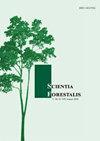配对集水区与原生植被作为参考在森林种植地区的溪流水质
IF 0.4
4区 农林科学
Q4 FORESTRY
引用次数: 0
摘要
快速生长的森林人工林可以改变流域水文动态和溪流水质,例如在森林采伐后浊度增加。至关重要的是,森林管理业务必须同环境监测的执行情况联系起来,这样才有可能查明这些变化的程度,并有助于旨在减少和(或)减轻这种影响的适应性管理。本研究的目的是评估原生林的水质参数是否适合作为外来人工林水文监测的参考。该研究评估了种植松林和原生植被的集水区之间的水质值,并将其与法律框架中规定的限值进行了比较(第n°357/2005号决议)。结果表明:松林流域的水质参数值与原生林流域的水质参数值非常接近,均在法律规定的范围内。因此,对于促进物理-化学参数变化很少的活动,例如造林活动,人们观察到,作为参考的最佳水质标准是在受到保护的原生植被影响的溪流中建立的水质标准,这些植被的地貌特征是相似的,因此配对集水区很重要。因此,在原始森林集水区观测到的值可以作为建立最大允制值(mpv)的参考,该值更具限制性且符合当地人工林的实际情况。1 .监测本文章由计算机程序翻译,如有差异,请以英文原文为准。
Paired catchments with native vegetation as a reference for water quality in streams in forest plantation areas
catchments a Abstract Fast-growing forest plantations can alter catchment hydrological dynamics and stream water quality, for example with turbidity increase after forest harvesting. It is essential that forest management operations be linked to the performance of environmental monitoring, making it possible to identify the magnitude of these changes and contributing to adaptive management aiming to reduce and/or mitigate such effects. The aim of this study was to assess if water quality parameters of native forest are suitable for use as a reference for hydrological monitoring of exotic forest plantations. The study evaluated the water quality values between catchments with Pinus plantation and native vegetation, comparing them with limits established in the legal framework (Resolution n° 357/2005). The results show that the values of the water quality parameters of the stream located in the Pinus plantation catchment are very similar to those observed in the native forest catchment, both of which are within the limits established by legal framework. Thus, for activities that promote few changes in physical-chemical parameters, such as in the case of forest plantations, it was observed that best water quality standard to be used as reference is the one established in streams under the influence of conserved native vegetation, whose geomorphological characteristics are similar, hence the importance of paired catchments. Therefore, the values observed in native forest catchment can serve as reference for establishing maximum permitted values (MPVs) that are more restrictive and consistent with the local reality of forest plantations. monitoramento O limites estabelecidos (Resolução Os resultados mostram que os parâmetros de qualidade da água do riacho localizado na microbacia com plantações de são muito semelhantes aos observados no riacho da microbacia de floresta dentro limites atividades alterações nos parâmetros físico-químicos, como o de o melhor qualidade utilizado influência características geomorfológicas microbacias floresta nativa de referência para o estabelecimento de valores máximos permitidos (VMPs) mais restritivos e coerentes com a realidade local das plantações florestais.
求助全文
通过发布文献求助,成功后即可免费获取论文全文。
去求助
来源期刊

Scientia Forestalis
Agricultural and Biological Sciences-Forestry
CiteScore
1.00
自引率
0.00%
发文量
39
期刊介绍:
Scientia Forestalis is a scientific publication of the IPEF – Institute of Forest Research and Studies, founded in 1968, as a nonprofit institution, in agreement with the LCF – Department of Forest Sciences of the ESALQ – Luiz de Queiroz College of Agriculture of the USP – São Paulo University. Scientia Forestalis, affiliated to the ABEC – Brazilian Association of Scientific Publishers, publishes four issues per year of original papers related to the several fields of the Forest Sciences.
The Editorial Board is composed by the Editor, the Scientific Editors (evaluating the manuscript), and the Associated Editors (helping on the decision of acceptation or not of the manuscript, analyzed by the Peer-Reviewers.
 求助内容:
求助内容: 应助结果提醒方式:
应助结果提醒方式:


